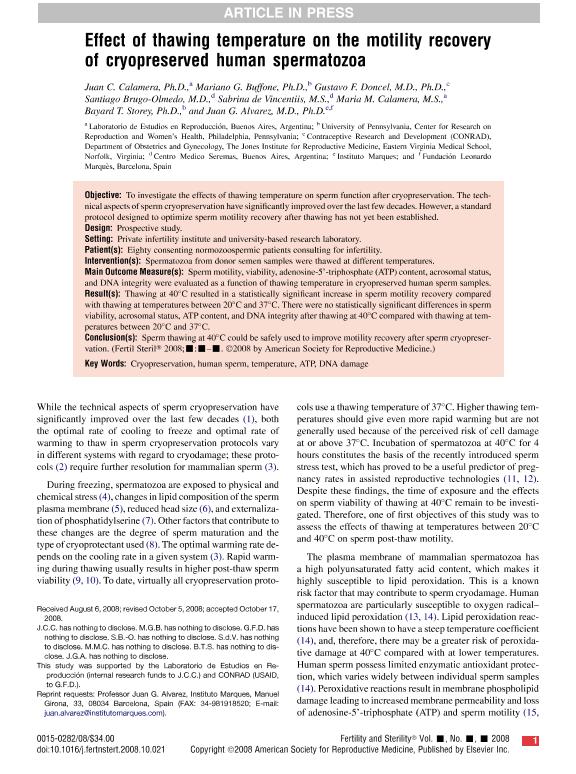Mostrar el registro sencillo del ítem
dc.contributor.author
Calamera, Juan C.
dc.contributor.author
Buffone, Mariano Gabriel

dc.contributor.author
Doncel, Gustavo F.
dc.contributor.author
Brugo Olmedo, Santiago
dc.contributor.author
de Vincentiis, Sabrina
dc.contributor.author
Calamera, Maria M.
dc.contributor.author
Storey, Bayard T.
dc.contributor.author
Alvarez, Juan G.
dc.date.available
2017-04-03T17:51:19Z
dc.date.issued
2010-02
dc.identifier.citation
Calamera, Juan C.; Buffone, Mariano Gabriel; Doncel, Gustavo F.; Brugo Olmedo, Santiago; de Vincentiis, Sabrina; et al.; Effect of thawing temperature on the motility recovery of cryopreserved human spermatozoa; Elsevier; Fertility And Sterility; 93; 3; 2-2010; 789-794
dc.identifier.issn
0015-0282
dc.identifier.issn
1556-5653
dc.identifier.uri
http://hdl.handle.net/11336/14695
dc.description.abstract
Objective
To investigate the effects of thawing temperature on sperm function after cryopreservation. The technical aspects of sperm cryopreservation have significantly improved over the last few decades. However, a standard protocol designed to optimize sperm motility recovery after thawing has not yet been established.
Design
Prospective study.
Setting
Private infertility institute and university-based research laboratory.
Patient(s)
Eighty consenting normozoospermic patients consulting for infertility.
Intervention(s)
Spermatozoa from donor semen samples were thawed at different temperatures.
Main Outcome Measure(s)
Sperm motility, viability, adenosine-5'-triphosphate (ATP) content, acrosomal status, and DNA integrity were evaluated as a function of thawing temperature in cryopreserved human sperm samples.
Result(s)
Thawing at 40°C resulted in a statistically significant increase in sperm motility recovery compared with thawing at temperatures between 20°C and 37°C. There were no statistically significant differences in sperm viability, acrosomal status, ATP content, and DNA integrity after thawing at 40°C compared with thawing at temperatures between 20°C and 37°C.
Conclusion(s)
Sperm thawing at 40°C could be safely used to improve motility recovery after sperm cryopreservation.
dc.format
application/pdf
dc.language.iso
eng
dc.publisher
Elsevier

dc.rights
info:eu-repo/semantics/openAccess
dc.rights.uri
https://creativecommons.org/licenses/by-nc-sa/2.5/ar/
dc.subject
Sperm
dc.subject
Criopreservation
dc.subject
Temperature
dc.subject
Dna Damage
dc.subject.classification
Biología Reproductiva

dc.subject.classification
Ciencias Biológicas

dc.subject.classification
CIENCIAS NATURALES Y EXACTAS

dc.title
Effect of thawing temperature on the motility recovery of cryopreserved human spermatozoa
dc.type
info:eu-repo/semantics/article
dc.type
info:ar-repo/semantics/artículo
dc.type
info:eu-repo/semantics/publishedVersion
dc.date.updated
2017-03-23T18:22:21Z
dc.journal.volume
93
dc.journal.number
3
dc.journal.pagination
789-794
dc.journal.pais
Países Bajos

dc.journal.ciudad
Amsterdam
dc.description.fil
Fil: Calamera, Juan C.. Laboratorio de Estudios de la Reproducción LER; Argentina
dc.description.fil
Fil: Buffone, Mariano Gabriel. Consejo Nacional de Investigaciones Científicas y Técnicas. Instituto de Biología y Medicina Experimental (i); Argentina; Argentina. University of Pennsylvania; Estados Unidos
dc.description.fil
Fil: Doncel, Gustavo F.. Eastern Virginia Medical School. Jones Institute For Reproductive Medicine; Estados Unidos
dc.description.fil
Fil: Brugo Olmedo, Santiago. Centro Médico Seremas; Argentina
dc.description.fil
Fil: de Vincentiis, Sabrina. Centro Médico Seremas; Argentina
dc.description.fil
Fil: Calamera, Maria M.. Laboratorio de Estudios de la Reproducción LER; Argentina
dc.description.fil
Fil: Storey, Bayard T.. University of Pennsylvania; Estados Unidos
dc.description.fil
Fil: Alvarez, Juan G.. Instituto Marques; España. Fundación Leonardo Marques; España
dc.journal.title
Fertility And Sterility

dc.relation.alternativeid
info:eu-repo/semantics/altIdentifier/doi/http://dx.doi.org/10.1016/j.fertnstert.2008.10.021
dc.relation.alternativeid
info:eu-repo/semantics/altIdentifier/url/http://www.sciencedirect.com/science/article/pii/S0015028208042830
Archivos asociados
